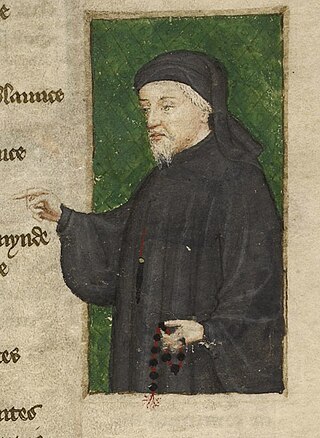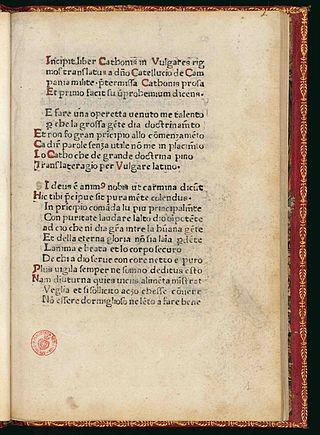Notes
 This article incorporates text from a publication now in the public domain : Gilman, D. C.; Peck, H. T.; Colby, F. M., eds. (1905). "Nigel". New International Encyclopedia (1st ed.). New York: Dodd, Mead.
This article incorporates text from a publication now in the public domain : Gilman, D. C.; Peck, H. T.; Colby, F. M., eds. (1905). "Nigel". New International Encyclopedia (1st ed.). New York: Dodd, Mead.
Nigel de Longchamps, also known as Nigel Wireker, (fl. c. 1190, died c. 1200), [1] Neel de Longchamps, or Nigel of Canterbury, was an Anglo-Norman satirist and poet of the late twelfth century, writing in Latin. He is known to have been a monk of Christ Church, Canterbury, from 1186 to 1193, and perhaps earlier (he claims to have met Thomas Becket, killed in 1170).
He is the author of the Speculum stultorum (A Mirror of Fools), a satire in Latin elegiac verse on the clergy and society in general. The hero is Burnellus, or Brunellus, a foolish ass, who goes in search of a means of lengthening his tail. Brunellus first visits Salernum to obtain drugs for this purpose. However, he loses these when attacked by a Cistercian monk with dogs. He then goes to Paris to study, but makes no progress there, being unable to remember the city's name after eight years of study. He then decides to join a religious order, but instead founds a new one by taking the easiest parts from the rules of other orders. Finally, his master recaptures him.
The poem was immensely popular for centuries. Under the title "Daun Burnel the Asse" it is mentioned by Chaucer in his Canterbury Tales, in the Nun's Priest's Tale.
Many other short Latin poems from a thirteenth-century manuscript are attributed to him, along with a prose treatise, Contra Curiales et Officinales Clericos. This treatise is an affectionate reproof to William Longchamp the Chancellor, in his role as Bishop of Ely. Wireker takes his intimate friend (possibly a relative) to task for attempting to combine Church with State.

Geoffrey Chaucer was an English poet, author, and civil servant best known for The Canterbury Tales. He has been called the "father of English literature", or, alternatively, the "father of English poetry". He was the first writer to be buried in what has since come to be called Poets' Corner, in Westminster Abbey. Chaucer also gained fame as a philosopher and astronomer, composing the scientific A Treatise on the Astrolabe for his 10-year-old son Lewis. He maintained a career in the civil service as a bureaucrat, courtier, diplomat, and member of parliament.
Old English literature refers to poetry and prose written in Old English in early medieval England, from the 7th century to the decades after the Norman Conquest of 1066, a period often termed Anglo-Saxon England. The 7th-century work Cædmon's Hymn is often considered as the oldest surviving poem in English, as it appears in an 8th-century copy of Bede's text, the Ecclesiastical History of the English People. Poetry written in the mid 12th century represents some of the latest post-Norman examples of Old English. Adherence to the grammatical rules of Old English is largely inconsistent in 12th-century work, and by the 13th century the grammar and syntax of Old English had almost completely deteriorated, giving way to the much larger Middle English corpus of literature.

Aldhelm, Abbot of Malmesbury Abbey, Bishop of Sherborne, and a writer and scholar of Latin poetry, was born before the middle of the 7th century. He is said to have been the son of Kenten, who was of the royal house of Wessex. He was certainly not, as his early biographer Faritius asserts, the brother of King Ine. After his death he was venerated as a saint, his feast day being the day of his death, 25 May.

John Gower was an English poet, a contemporary of William Langland and the Pearl Poet, and a personal friend of Geoffrey Chaucer. He is remembered primarily for three major works—the Mirour de l'Omme, Vox Clamantis, and Confessio Amantis—three long poems written in French, Latin, and English respectively, which are united by common moral and political themes.
Ælfric of Eynsham was an English abbot and a student of Æthelwold of Winchester, and a consummate, prolific writer in Old English of hagiography, homilies, biblical commentaries, and other genres. He is also known variously as Ælfric the Grammarian, Ælfric of Cerne, and Ælfric the Homilist. In the view of Peter Hunter Blair, he was "a man comparable both in the quantity of his writings and in the quality of his mind even with Bede himself." According to Claudio Leonardi, he "represented the highest pinnacle of Benedictine reform and Anglo-Saxon literature".
Richard of Cirencester was a cleric and minor historian of the Benedictine abbey at Westminster. He was highly famed in the 18th and 19th century as the author of The Description of Britain before it was proved to have been a later forgery in 1846.

William de Longchamp was a medieval Lord Chancellor, Chief Justiciar, and Bishop of Ely in England. Born to a humble family in Normandy, he owed his advancement to royal favour. Although contemporary writers accused Longchamp's father of being the son of a peasant, he held land as a knight. Longchamp first served Henry II's illegitimate son Geoffrey, but quickly transferred to the service of Richard I, Henry's heir. When Richard became king in 1189, Longchamp paid £3,000 for the office of Chancellor, and was soon named to the see, or bishopric, of Ely and appointed legate by the pope.

"The Nun's Priest's Tale" is one of The Canterbury Tales by the Middle English poet Geoffrey Chaucer. Composed in the 1390s, it is a beast fable and mock epic based on an incident in the Reynard cycle. The story of Chanticleer and the Fox became further popularised in Britain through this means.

The General Prologue is the first part of The Canterbury Tales by Geoffrey Chaucer. It introduces the frame story, in which a group of pilgrims travelling to the shrine of Thomas Becket in Canterbury agree to take part in a storytelling competition, and describes the pilgrims themselves. The Prologue is arguably the most familiar section of The Canterbury Tales, depicting traffic between places, languages and cultures as well as introducing and describing the pilgrims who will narrate the tales.

The Distichs of Cato, is a Latin collection of proverbial wisdom and morality by an unknown author from the 3rd or 4th century AD. The Cato was the most popular medieval schoolbook for teaching Latin, prized not only as a Latin textbook, but as a moral compass. Cato was in common use as a Latin teaching aid as late as the 18th century, used by Benjamin Franklin. It was one of the best-known books in the Middle Ages and was translated into many languages.

The Vespasian Psalter is an Anglo-Saxon illuminated psalter decorated in a partly Insular style produced in the second or third quarter of the 8th century. It contains an interlinear gloss in Old English which is the oldest extant English translation of any portion of the Bible. It was produced in southern England, perhaps in St. Augustine's Abbey or Christ Church, Canterbury or Minster-in-Thanet, and is the earliest illuminated manuscript produced in "Southumbria" to survive.

Albert Stanburrough Cook was an American philologist, literary critic, and scholar of Old English. He has been called "the single most powerful American Anglo-Saxonist of the nineteenth and twentieth centuries."

Amis et Amiles is an old French romance based on a widespread legend of friendship and sacrifice. In its earlier and simpler form it is the story of two friends, one of whom, Amis, was sick with leprosy because he had committed perjury to save his friend. A vision informed him that he could only be cured by bathing in the blood of Amiles's children. When Amiles learnt this he killed the children, who were, however, miraculously restored to life after the cure of Amis.

This article presents lists of the literary events and publications in the 12th century.

Byrhtferth was a priest and monk who lived at Ramsey Abbey in Huntingdonshire in England. He had a deep impact on the intellectual life of later Anglo-Saxon England and wrote many computistic, hagiographic, and historical works. He was a leading man of science and best known as the author of many different works. His Manual (Enchiridion), a scientific textbook, is Byrhtferth's best known work.

The medieval genre of speculum literature, popular from the twelfth through the sixteenth centuries, was inspired by the urge to encompass encyclopedic knowledge within a single work. However, some of these works have a restricted scope and function as instructional manuals. In this sense, the encyclopedia and the speculum are similar but they are not the same genre.

Cædmon's Hymn is a short Old English poem attributed to Cædmon, a supposedly illiterate and unmusical cow-herder who was, according to the Northumbrian monk Bede, miraculously empowered to sing in honour of God the Creator. The poem is Cædmon's only known composition.
Edward Churton was an English churchman and Spanish scholar.

Gillian Lesley "Jill" Mann, FBA, is a scholar known for her work on medieval literature, especially on Middle English and Medieval Latin.